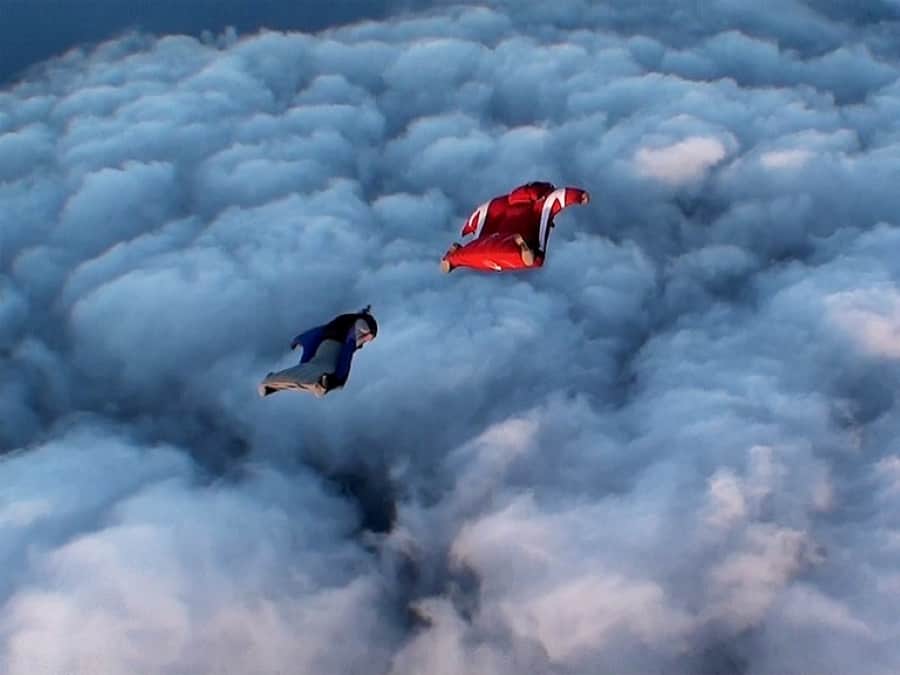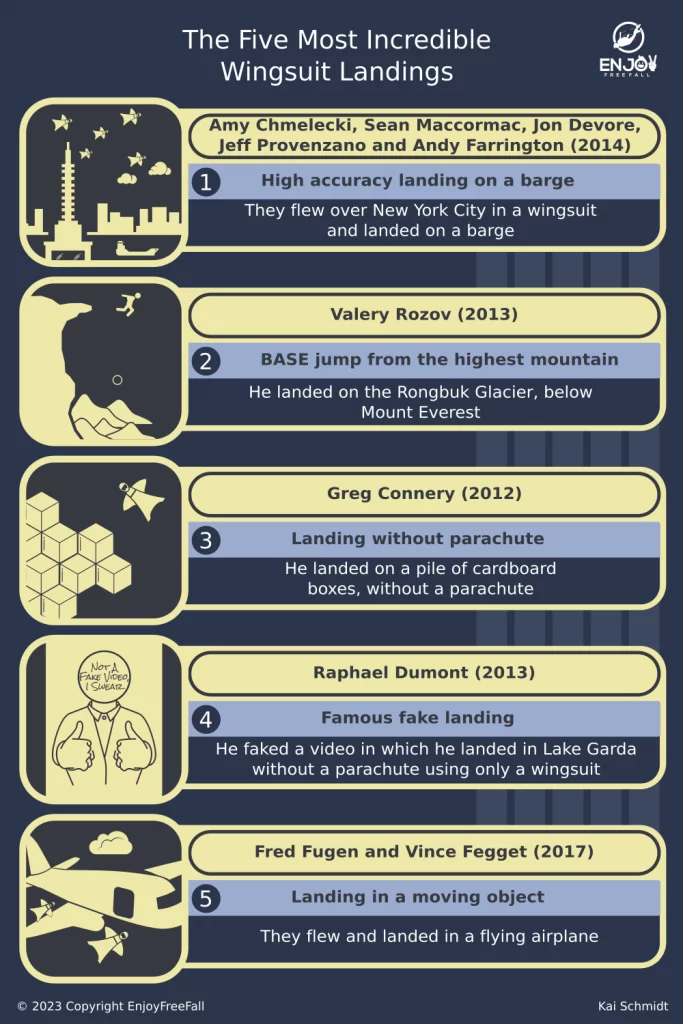
Wingsuit pilots soar through the sky at incredible speeds, but have you ever wondered how they safely land? With such a unique flying experience, the landing process must be equally unique. But how do wingsuit pilots land?
Wingsuit pilots land using a parachute specifically created for skydiving or BASE jumping. Once the parachute has been deployed, the pilot has to unzip his arm wings to reach the toggles and steer his parachute to his designated landing area.
While it’s true that wingsuit pilots are expected to land on the designated landing areas of a drop zone, there are instances where they can also make their landings at off-field locations.
In this article, I’ve summarized the process and techniques you need to know to ensure you carry out a successful landing. I’ve also provided brief snippets of the most incredible wingsuit landings of all time. Read on!
Wingsuit Pilots Land Using a Parachute
Wingsuit flying has two categories:
- Skydiving if you are exiting an airplane, helicopter, and air balloon; or
- BASE jumping if you are jumping out from a fixed location such as a building, cliff, and mountain top.
Skydivers and BASE jumpers use parachutes that are designed to easily open when deployed at their specific altitudes. BASE jumpers have larger pilot chutes and parachutes (e.g., wing load of around 0.7 lbs./sq ft) due to lower airspeed deployments, and in some cases, they also have the sliders removed to ensure a faster opening.
Once their parachute is opened, wingsuit pilots need to immediately reach and unzip their arm wings so that they can easily reach and control the toggles for a safe landing.
While under a perfectly working canopy, wingsuit flyers often enjoy performing different maneuvers such as a left or right turn or 360-degree turn. They can even practice flaring exercises before preparing for their landing approach.
What Is the Difference Between BASE Jumping and Skydiving Wingsuit Flying?
The main difference between skydiving and BASE jumping wingsuit flying is that skydivers have two parachutes (main and reserve) while BASE jumpers normally carry just a single parachute (no reserve).
The reason why BASE jumpers often do not carry a reserve parachute is that they would not have the time to deploy it anyway. As the exit height for BASE jumping is so low compared to skydiving, the reserve parachute mostly would not inflate in time, even if deployed quickly after the first one.
The advantage of not having a second parachute is that it makes the BASE jumping containers less bulky compared to skydiving containers that have a cutaway system and a second parachute.
Base jumpers can therefore save weight which would otherwise reduce their speed and flight distance. (A modern BASE system only weighs around 8.6 lbs. (3.9 kgs))
If you want to dive deeper into factors that influences the wingsuit flying speed and distance, check out my post about “the farthest wingsuits flights” and “the fastest wingsuit flights”.
What Are the Different Parachute Landing Techniques After a Wingsuit Flight?
Whether wingsuiting from an airplane or performing a BASE jump, wingsuit pilots use the same parachute landing technique and choose to land in either a sitting or standing position.
The sitting or slide-in position is widely used by beginners and tandem skydivers. It is considered a safe landing position because it is less prone to injury. To perform landing in this position, wingsuit pilots need to lift their legs in front with their toes pointing to the sky as they are approaching the ground. As a result, they will land on their behind or buttocks.
Landing in the standing position simply requires the wingsuit pilot to land on their feet and stand on the ground. It is used by more experienced wingsuit pilots and solo skydivers and only occasionally by tandem jumpers.
Landing can be challenging at first, but practice makes perfect – just make sure that the ground condition is conducive and suitable to perfectly execute this type of landing.
If you are training your landing techniques, remember that this is the most dangerous part of skydiving so helmets are a must. However, have you ever thought of other reasons to wear a helmet aside from it primarily protects the head? Check out my article about it where I delve into another aspect which is the regulations tied to it and its significance to various levels, disciplines and locations.
The Five Most Incredible Wingsuits Landings
Depending on the jumping conditions, some wingsuit pilots can also land at off-site locations. Surprisingly, some daredevil wingsuit pilots even test their limits and try to land without the aid of a parachute. Here are five of the most incredible wingsuit landings, some with and others without a parachute.
| Name of Skydiver | Year | Particularity | Explanation | Video link |
| Amy Chmelecki, Sean Maccormac, Jon Devore, Jeff Provenzano, Andy Farrington | 2014 | High accuracy landing on a barge | They flew over New York City in a wingsuit and landed on a barge | Link |
| Valery Rozov | 2013 | BASE jump on the highest mountain | He landed on the Rongbuk Glacier, below Mount Everest | Link |
| Greg Connery | 2012 | Landing without parachute | He landed on a pile of cardboard boxes, without a parachute | Link |
| Raphael Dumont | 2013 | Famous fake landing | He faked a video in which he landed in Lake Garda without a parachute using a wingsuit only | Link |
| Fred Fugen, Vince Fegget | 2017 | Landing in a moving object | They flew and landed in a flying airplane | Link |
1. Red Bull Air Force Wingsuit Pilots – Flew Over New York City in a Wingsuit and Landed on a Barge
In 2014, five members of the Red Bull Air Force namely Amy Chmelecki, Sean Maccormac, Jon Devore, Jeff Provenzano, and Andy Farrington jumped out of a plane at between 7,500-8000 ft (at the tip of Governor’s Island). They flew in their wingsuits over New York City and successfully landed on a small barge in the middle of the Hudson River.
The group had known each other for almost 18 years prior to the jump and so had a great understanding of each other. They also made sure that the entire jump would be safe by hiring a ground crew that monitored the ground wind to ensure that they wouldn’t miss their landing area and land in the water.
Not many people can say about themselves that they flew at around 80 mph above New York City.
As you’re aware, even a minor error in skydiving can have severe consequences, making it a high-risk activity. If you are interested in learning more about the disadvantages of skydiving as a hobby, check out my article about the 9 reasons why you shouldn’t start skydiving as a hobby. This will give you insights that will help determine if skydiving is a suitable hobby for you.

2. Valery Rozov – Landed on the Rongbuk Glacier, Below Mount Everest
On 5 May 2013, Valery Rozov, a Russian BASE jumper flew from Changtse (the Chinese side and the northernmost peak of Mount Everest) and landed on the Rongbuk Glacier – 4,000 ft below!
His expedition had been two years in the making as it involved preparing to face the super strong winds and extremely cold temperatures of the Himalayas. Valery’s planned jump site was at 23,688 ft (7,220 m) ASL and required him to have oxygen supplied to him. He reached the location after hiking for four days from his base camp.
After jumping, it took Valery a lot longer than normal to get from falling to flying. He flew for about a minute with a speed of 125 mph (200 km/h) before safely landing as planned on the Rongbuk Glacier in a sitting/ slide-in position.
By that time, Valery was able to set his personal and the World Record for the highest BASE jump on the peak of Mount Everest!
3. Greg Connery – Landed on a Pile of Cardboard Boxes, Without a Parachute
Greg Connery is a professional skydiver, BASE jumper, and stuntman. He performed several movie stunts and played stunt double for Leonardo DiCaprio, Rowan Atkinson, and Queen Elizabeth II during the opening ceremony of the 2012 Olympics which was held in London.
On 23 March 2012, the wingsuit daredevil jumped from a helicopter at the height of 2,400 ft (730 m) and landed safely on the ground without the help of a parachute.
Within just a few seconds after his jump, he gained a speed of around 80 mph (130 km/h) and with the help of his specially designed wingsuit, he was able to decrease his glide rate to around 50 mph (80 km/h) and vertical fall to around 15 mph (24 km/h).
To absorb his impact, Greg had made a landing strip using 18,600 cardboard boxes measuring 350 ft (110 m) in length, 45 ft (14 m) in width, and 12 ft (3.7 m) in height. He also wore a neck brace to ensure a safe landing and to avoid possible neck injury since he chose to land head first.
He was acknowledged as the first wingsuit pilot to land without a parachute which was a lifelong dream for many wingsuit enthusiasts.
That was impressive, right? Would you like to discover more inspiring stories of individuals who continue to pursue extraordinary jumps even in their later years? In my article on skydiving age limits, I share extraordinary jumps of older people and discuss the age and physical requirements involved.
4. Raphael Dumont – Fake Water Landing in Lake Garda, Italy
On 8 October 2013, Raphael Dumont, age 31, a professional skydiver and wingsuit pilot went to Lake Garda, Italy to attempt and set a new World Record as the first wingsuit pilot to perform a water landing without the aid of a parachute.
It took him 2 hours to reach his desired spot at the mountain from where he began his freefall, glided over the edge of the mountain, and through the Lake where a cheerful audience awaited him. After a few moments, Raphael successfully landed in the water – fortunately without any injury.
The video of his accomplishment instantly went viral and was shared 32,000 times across Facebook and Twitter on the same night of its release!
Although instantly popular, there was a public debate amongst its audience as to whether Raphael’s jump was fake or not. Some people claimed that it has poor editing, video quality, and that the landing was too smooth given the supposed speed of the fall. Other said it was real.
It was later revealed by the makers that the video was fake and that Raphael Dumont was just a fictional character.
If you want to read more about the possible water landings without a parachute, you can check out this post.
5. Fred Fugen and Vince Fegget – Base Jumped Into a Plane Mid-Air
French wingsuit pilots Fred Fugen and Vince Reffet, popularly known as the Soul Flyers, made a death-defying stunt to land inside an airplane while it was in mid-flight!
Their project, a partnership with Red Bull codenamed “A Door in the Sky” and undertaken after several months of intensive and rigorous training was a massive success.
The duo completed around 100 practice wingsuit flights in Spain to make sure that they were well-prepared for their one-shot chance at glory.
After all, even with a slight miscalculation, they could end up being minced to death in the plane’s propeller.
To execute their stunt, the pair went to the top of one of the highest mountains in Europe – The Jungfrau mountain from where they BASE jumped and flew alongside a Pilatus Porter light aircraft.
When the plane achieved the right angle and speed, they aimed for the door (right side) and slowly began their approach.
The inside of the plane was lined with cushions to prevent them from impacting the floor or inside wall of the plane hard. Once inside, the men were secured by another team member.
If you would like to see more of the incredible wingsuit flights, make sure to read my article about the 13 most mind-blowing wingsuit jumps. You will be stunned by seeing how these daredevils pushed the boundaries of wingsuit flying!
Enjoy your freefall!
Photo Credits
Richard Schneider from Los Angeles, CC BY 2.0 <https://creativecommons.org/licenses/by/2.0>, via Wikimedia Commons, cropped


